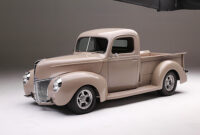Old International Semi Trucks For Sale: A Comprehensive Guide to Buying a Vintage Workhorse pickup.truckstrend.com
In the ever-evolving world of commercial transportation, where sleek, modern rigs dominate the highways, a distinct allure remains for the robust, time-tested machines of yesteryear. Among these, Old International semi trucks stand out, representing a legacy of American engineering, durability, and a simpler approach to heavy-duty hauling. For enthusiasts, small business owners, or those seeking an affordable entry into the trucking world, the search for an Old International semi truck for sale isn’t just a transaction; it’s an exploration into a rich history and a potential investment in a truly unique vehicle.
This comprehensive guide will delve into the world of vintage International semi trucks, exploring their enduring appeal, what to look for, where to find them, and the practical considerations for bringing one of these classic workhorses back to life or putting it back to work.
Old International Semi Trucks For Sale: A Comprehensive Guide to Buying a Vintage Workhorse
The Enduring Legacy of International Harvester/Navistar
The story of International semi trucks begins with International Harvester (IH), a powerhouse of American manufacturing established in 1902. Renowned for its agricultural machinery, construction equipment, and trucks, IH built a reputation for ruggedness and reliability. Their trucks, particularly the heavy-duty models, became synonymous with dependability on farms, construction sites, and highways across North America.
In the mid-1980s, facing financial challenges, International Harvester spun off its agricultural division and reorganized its truck and engine business as Navistar International Corporation. While the name changed, the commitment to building tough, capable trucks under the "International" brand continued. This lineage means that "Old International" can refer to trucks from various eras – from the classic, pre-1980s International Harvester models to the slightly newer, but still vintage, Navistar-era trucks from the 80s and 90s. This enduring legacy is precisely why these trucks are still sought after today, admired for their straightforward mechanics, robust frames, and often distinctive styling.
Why Buy an Old International Semi Truck? Benefits & Appeal
The decision to purchase an Old International semi truck often stems from a blend of practical benefits and an appreciation for vintage machinery.
Cost-Effectiveness
One of the most immediate advantages is the initial purchase price. Compared to new semi trucks, which can easily cost upwards of $150,000 to $200,000, a well-maintained Old International can be acquired for a fraction of that, often ranging from $5,000 to $30,000 depending on condition and model. This affordability makes them an attractive option for owner-operators on a budget, small businesses, or hobbyists.
Durability & Longevity

International trucks were built to last. Many models feature heavy-duty frames, robust axles, and mechanical systems designed for arduous work. It’s not uncommon to find these trucks with hundreds of thousands, if not a million, miles on them, still running strong. Their simpler designs often translate to fewer complex electronic components that can fail, contributing to their longevity.
Simpler Maintenance & Repair
Modern semi trucks are technological marvels, but their intricate computer systems and proprietary diagnostics can make repairs costly and complex, often requiring specialized dealer tools. Old International trucks, particularly those from before the late 1990s, are generally much simpler mechanically. This means that many common repairs can be performed by a competent mechanic (or even a skilled owner) without needing advanced software, potentially saving significant labor costs. Parts, while sometimes requiring a bit of searching, are often available through aftermarket suppliers, salvage yards, or online communities.
Classic Appeal & Nostalgia
For many, the appeal is purely aesthetic and nostalgic. These trucks represent an era of American trucking that evokes a sense of freedom, power, and rugged individualism. They are popular for restoration projects, classic truck shows, or simply for those who appreciate the look and feel of a vintage machine.
Unique Work Applications
While not suited for long-haul, time-sensitive freight due to potential fuel economy and speed limitations, Old International trucks excel in specialized roles. They are often ideal for local hauling, farm use, grain operations, logging, construction site work, or as dedicated yard trucks. Their robust nature makes them perfect for tasks where a modern, high-tech truck might be overkill or too delicate.
Customization Potential
For those with a vision, an Old International can be a blank canvas. Whether it’s a full frame-off restoration, a custom hot rod semi, or a practical work truck with modern comforts added, these trucks offer immense potential for personalization.
Key Models to Look For
International produced a vast array of heavy-duty trucks over the decades. Here are some notable series that frequently appear on the used market:
- S-Series (e.g., S1900, S2500): Introduced in the late 1970s, the S-Series became a workhorse for many industries. They were versatile, offered various engine and transmission options, and are known for their rugged dependability. Many are still in service today.
- COE (Cab-Over-Engine) Models (e.g., Transtar, 9600, 9700, 9800): International was a significant player in the COE market. Models like the Transtar (from the 1970s) and the later 9600/9700/9800 series were popular for their maneuverability and shorter overall length, which was advantageous under certain length regulations. The 9800 Eagle, with its distinctive styling, remains a favorite.
- Conventional Models (e.g., 4000 Series, 7000 Series, 9000 Series, Paystar): These traditional long-nose trucks were built for heavy-duty applications. The Paystar, in particular, was known as a severe-service truck, often used in construction, logging, and refuse. The later 9000 series (like the 9200, 9400, 9900i) continued the conventional styling with improved aerodynamics and more modern amenities.
Many of these trucks can be found with popular engine options from Cummins (NTC, Big Cam, L10, M11, N14), Detroit Diesel (Series 60), Caterpillar (3406, C15), or International’s own engines (DT466, 466E, 530, 570, early MaxxForce).
Important Considerations Before Buying
While the appeal of an Old International is strong, a wise buyer will approach the purchase with a clear understanding of the challenges.
- Condition Assessment: This is paramount. Look for rust on the frame, cab, and critical components. Inspect the engine for leaks, signs of blow-by, and proper starting. Check the transmission for smooth shifting, the brakes for wear, and the tires for condition and age. A pre-purchase inspection by a qualified heavy-duty mechanic is highly recommended.
- Parts Availability: While many common wear items and powertrain components (like Cummins or Detroit Diesel engine parts) are still readily available, some model-specific body parts, interior pieces, or specialized International engine components can be challenging to source. Online forums, specialized vintage truck parts suppliers, and salvage yards will become your best friends.
- Maintenance & Repair Costs: Even if repairs are simpler, older trucks often require more frequent attention. Be prepared for ongoing maintenance expenses, including fluids, filters, belts, and potential component overhauls.
- Emissions Regulations: This is perhaps the biggest hurdle for older diesel trucks. Many regions, especially in California and parts of the Northeast, have strict emissions laws that can make it difficult or impossible to register and operate pre-2007 (or even pre-2000) diesel trucks for commercial use on public roads. Always check local and state regulations before purchasing, especially if you plan to use the truck commercially. For farm use or off-road applications, these regulations may not apply.
- Fuel Economy: Older diesel engines are generally less fuel-efficient than their modern counterparts. Factor this into your operating costs, especially if planning significant mileage.
- Safety Features: Old International trucks lack the advanced safety features found in modern rigs, such as electronic stability control, lane departure warning, collision mitigation systems, and multiple airbags.
- Insurance: Obtaining commercial insurance for a very old semi truck can sometimes be more complex or costly than for a newer model, especially if it’s considered a "classic" or "antique" rather than just a commercial vehicle.
- Title and Registration: Ensure the truck has a clear title and that all VINs match. Verify any liens or outstanding financial obligations.
Where to Find Old International Semi Trucks for Sale
The hunt for a vintage International can be an adventure in itself.
- Online Marketplaces:
- TruckPaper.com & CommercialTruckTrader.com: While often listing newer trucks, these sites also have sections for older or classic models.
- eBay Motors: A good source for both running trucks and restoration projects.
- Craigslist & Facebook Marketplace: Excellent for finding private sellers and local deals, often at lower prices. Be wary of scams and always inspect in person.
- Specialized Forums & Facebook Groups: Many online communities are dedicated to vintage International trucks. Members often post trucks for sale or know where to find them.
- Auctions:
- Ritchie Bros. Auctioneers & IronPlanet: Large-scale industrial auctions that occasionally feature older semi trucks.
- Local Farm & Equipment Auctions: Often a goldmine for older, well-maintained farm trucks or project vehicles.
- Used Truck Dealerships: Some dealerships specialize in older or reconditioned commercial vehicles. They may offer a warranty, albeit limited.
- Private Sellers: Word-of-mouth, classified ads in local papers, or driving through rural areas can sometimes lead to unexpected finds.
- Salvage Yards/Truck Graveyards: If you’re looking for a project truck or specific parts, a visit to a large truck salvage yard can be fruitful.
Tips for a Successful Purchase
- Set a Realistic Budget: Beyond the purchase price, factor in transportation costs, immediate repairs, potential upgrades, and ongoing maintenance.
- Thorough Inspection is Key: Don’t just kick the tires. Spend time inspecting the frame for cracks or heavy rust, check the engine for smoke (especially black or blue), listen for unusual noises, and examine the interior for wear and tear.
- Test Drive: If possible and safe, take the truck for a test drive. Check the brakes, steering, transmission shifting (both up and down), and listen for drivetrain noises. Ensure all gauges work.
- Verify Documentation: Confirm the title is clear and matches the truck’s VIN. Ask for any available service records.
- Negotiate: Most prices for older trucks are negotiable. Be prepared to walk away if the price isn’t right or if the seller isn’t transparent about the truck’s condition.
- Plan for Transport: If the truck isn’t roadworthy, arrange for a tow or professional transport to get it to your location.
Estimated Price Guide for Old International Semi Trucks
Prices for Old International semi trucks vary dramatically based on model, year, engine, condition, mileage, and location. This table provides a general estimate and should only be used as a guideline. Always conduct thorough research and inspection before making a purchase.
| Model Series (Examples) | Typical Year Range | Condition Category | Estimated Price Range (USD) | Key Considerations


